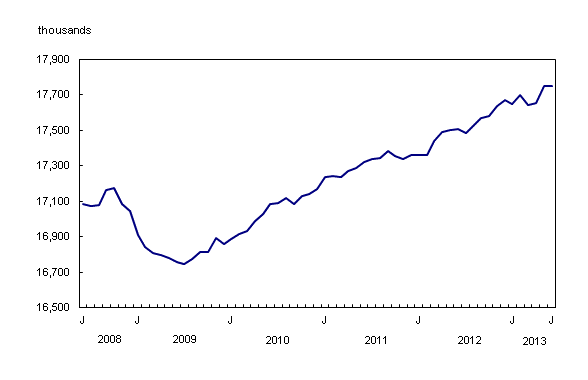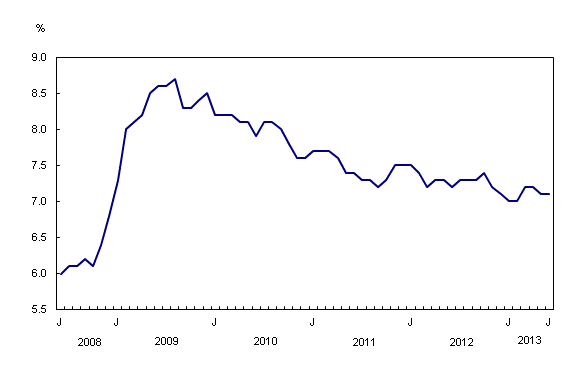Labour Force Survey, June 2013
Archived Content
Information identified as archived is provided for reference, research or recordkeeping purposes. It is not subject to the Government of Canada Web Standards and has not been altered or updated since it was archived. Please "contact us" to request a format other than those available.
Released: 2013-07-05
In June, employment was virtually unchanged and the unemployment rate remained at 7.1%. In the first half of 2013, employment growth averaged 14,000 per month, slower than the average of 27,000 in the last six months of 2012.
Over this 12-month period, employment grew by 1.4% (+242,000), and the total number of hours worked increased by 0.6%.
In June, employment increased in Manitoba and Saskatchewan, while it declined in New Brunswick and Prince Edward Island.
Employment rose in professional, scientific and technical services, and declined in accommodation and food services as well as information, culture and recreation.
In June, employment was little changed among the major demographic groups.
Collection and estimates in Southern Alberta
Floods in parts of southern Alberta began after the June reference week for the Labour Force Survey (LFS), which was from Sunday June 9 to Saturday June 15. The flooding occurred towards the end of the collection period.
While collection activities slowed in the affected communities that were in sample, final response rates for these communities were within normal range. Therefore, it is believed that the impact of the floods on June estimates was negligible.
In July, questions on the impact of the floods on hours worked will be added to the LFS, with estimates to be released in mid-August.
Employment up in Manitoba and Saskatchewan
The number of workers in Manitoba rose by 7,300 in June, offsetting declines earlier in the year. This gain pushed the unemployment rate down 0.7 percentage points to 5.0%. Compared with 12 months earlier, employment in the province was up 1.5%.
Following four months of little change, employment in Saskatchewan increased by 4,300 in June. With this gain, the unemployment rate fell 0.8 percentage points to 3.7%, the lowest among all provinces. On a year-over-year basis, employment in the province increased by 3.6%, the strongest growth rate in the country.
In June, employment declined by 5,200 in New Brunswick, returning to a level similar to that of December 2012. This decline pushed the unemployment rate up 0.7 percentage points to 11.2%. Compared with 12 months earlier, employment was down 2.2%.
Employment declined by 1,100 in Prince Edward Island in June, and was little changed from 12 months earlier. The unemployment rate was 10.9% in June.
Following an increase in May, employment in Ontario was little changed in June, as a gain in part-time work was offset by a decline in full-time work. The unemployment rate rose 0.2 percentage points to 7.5%. Compared with 12 months earlier, employment in the province was up 1.6%.
In Quebec, employment was little changed in June and the unemployment rate was 7.9%. On a year-over-year basis, employment rose 1.2%, with all the gains in the last six months of 2012.
Gains in professional, scientific and technical services
Employment in professional, scientific and technical services increased by 27,000 in June. Compared with 12 months earlier, employment grew by 4.9% (+63,000), one of the highest growth rates among all industries.
In June, there were declines in accommodation and food services (-20,000) and information, culture and recreation (-15,000).
While employment in construction was little changed in June, it increased 6.2% on a year-over-year basis. Employment in this industry has been on an upward trend since the autumn of 2012.
Manufacturing employment has been little changed in recent months, following a decline of 71,000 during the first three months of 2013.
The number of private and public sector employees and the self-employed was little changed in June. Compared with 12 months earlier, growth among private sector employees was 1.2% (+137,000), with all the gains in the second half of 2012. At the same time, the number of public sector employees was up 1.5% (+55,000), with increases spread throughout the period. As for the self-employed, growth was 1.9% (+51,000), the bulk of which occurred in the first quarter of 2013.
Student summer employment
From May to August, the Labour Force Survey collects labour market data about young people aged 15 to 24 who were attending school full time in March and who intend to return to school full time in the fall. The May and June survey results provide the first indicators of the summer job market, while the July and August data will provide further insight. The published data are not seasonally adjusted; therefore, comparisons can only be made on a year-over-year basis.
Among returning students aged 20 to 24, the employment rate was 68.0% in June, up from 63.2% in June 2012. Their unemployment rate was 11.4% in June, down from 13.0% a year earlier.
The employment rate for 17- to 19-year-old students was 51.9% in June, similar to the rate observed 12 months earlier. Over the same period, the unemployment rate for these students declined from 17.3% to 15.7%.
Quarterly update for the territories
The Labour Force Survey also collects labour market information about the territories. This information is produced monthly in the form of three-month moving averages. The following data are not seasonally adjusted; therefore, comparisons should only be made on a year-over-year basis.
In Yukon, employment increased by 600 from June 2012 to June 2013, and the unemployment rate fell from 7.8% to 5.3% over the same period.
Employment in Nunavut and the Northwest Territories was little changed in June 2013 compared with June 2012. Over the same period, the unemployment rate was down 2.0 percentage points to 13.7% in Nunavut, while it was little changed in the Northwest Territories.
Note to readers
The Labour Force Survey (LFS) estimates are based on a sample and are therefore subject to sampling variability. As a result, monthly estimates will show more variability than trends observed over longer time periods. Estimates for smaller geographic areas or industries also have more variability. For an explanation of sampling variability of estimates and how to use standard errors to assess this variability, consult the "Estimates quality" section of the publication Labour Force Information (Catalogue number71-001-X).
The employment rate is the number of employed persons as a percentage of the population 15 years of age and over. The rate for a particular group (for example, youth aged 15 to 24) is the number employed in that group as a percentage of the population for that group.
The unemployment rate is the number unemployed as a percentage of the labour force (employed and unemployed).
The participation rate is the number of employed and unemployed as a percentage of the population. For more detailed information, see the Guide to the Labour Force Survey (Catalogue number71-543-G).
Unless otherwise stated, this release presents seasonally adjusted estimates, which facilitates comparisons by removing the effects of seasonal variations. For more information on seasonal adjustment, see Seasonal adjustment and identifying economic trends.
Each year, the LFS revises its estimates for the previous three years, using the latest seasonal factors.
A more detailed summary, Labour Force Information (Catalogue number71-001-X), is now available online for the week ending June 15. From the Browse by key resource module of our website under Publications, choose All subjects, then Labour.
Data tables are also now available online. From the Browse by subject module of our website, choose Labour.
Labour market indicators are very popular among our data users. Therefore, we developed the Labour Market Indicators Desktop Application, a new tool that will give you quick access to Statistics Canada's latest labour market data directly from your computer desktop.
The next release of the Labour Force Survey will be on August 9.
Contact information
For more information, contact us (toll-free 1-800-263-1136; infostats@statcan.gc.ca).
To enquire about the concepts, methods or data quality of this release, contact Vincent Ferrao (613-951-4750; vincent.ferrao@statcan.gc.ca) or Lahouaria Yssaad (613-951-0627; lahouaria.yssaad@statcan.gc.ca), Labour Statistics Division.
- Date modified:



